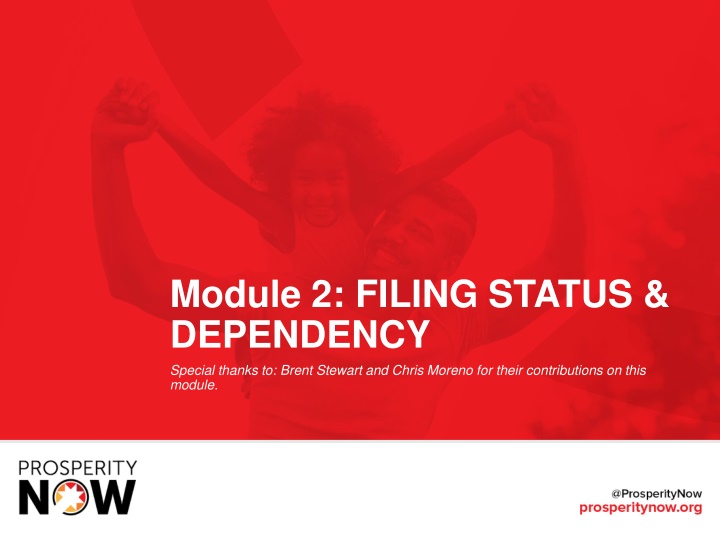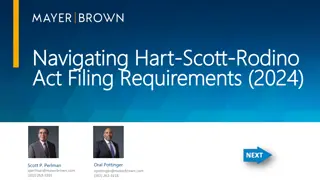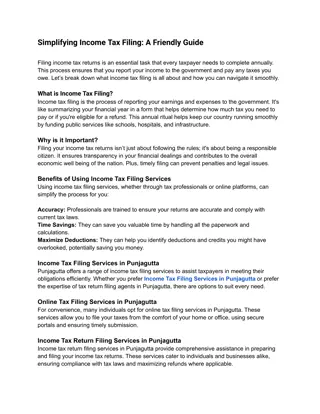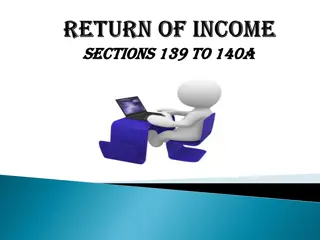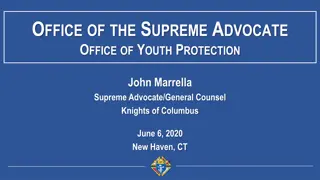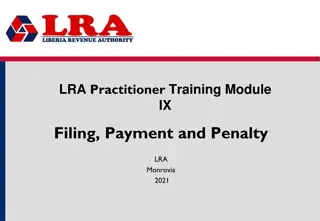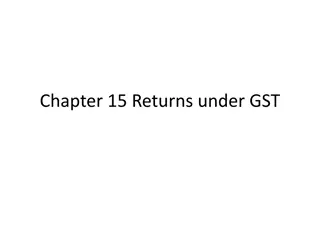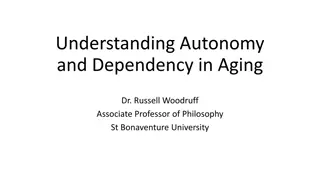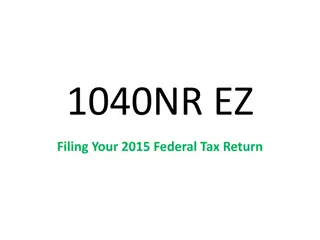Filing Status & Dependency Guidelines
Learn about the various filing statuses for tax returns, including Single, Head of Household, Married Filing Jointly, Married Filing Separately, and Qualifying Surviving Spouse. Understand the impact of filing status on tax deductions, thresholds, and credits. Explore how to determine the appropriate filing status and qualify dependents for tax purposes.
Uploaded on Feb 27, 2025 | 1 Views
Download Presentation

Please find below an Image/Link to download the presentation.
The content on the website is provided AS IS for your information and personal use only. It may not be sold, licensed, or shared on other websites without obtaining consent from the author.If you encounter any issues during the download, it is possible that the publisher has removed the file from their server.
You are allowed to download the files provided on this website for personal or commercial use, subject to the condition that they are used lawfully. All files are the property of their respective owners.
The content on the website is provided AS IS for your information and personal use only. It may not be sold, licensed, or shared on other websites without obtaining consent from the author.
E N D
Presentation Transcript
Module 2: FILING STATUS & DEPENDENCY Special thanks to: Brent Stewart and Chris Moreno for their contributions on this module.
By the end of this module you will Understand how to select the appropriate filing status Understand how filing status and dependents affect tax returns
In this module Filing Status Dependency Filing Status What is a Dependent? Determining Filing Status Who Qualifies as a Dependent? Impact of Filing Status Effects of Filing Status and Re-Cap Dependents on a Tax Return Knowledge Check Re-Cap Knowledge Check
Filing Status Each tax return must indicate one of five filing statuses for the tax filer(s): Single Head of Household (HOH) Married Filing Jointly (MFJ) Check out if they're living together or apart at the end of the year Married Filing Separately (MFS) Qualifying Surviving Spouse (QSS) Note: Any filing status where someone else (a parent) can claim the taxpayer as a dependent has a different filing threshold (minimum income requiring dependent to file a return)
Filing Status: Impact on the tax return The filing status determines the amount of the standard deduction, as well as other aspects of the tax return. For tax year 2022 returns, the standard deduction for each filing status is as follows: (these increase for 65+ and/or Blind taxpayers) Single & MFS: $12,950 MFJ and Qualifying Surviving Spouse: $25,900 Head of Household: $19,400 NOTE: Refer to Module 5 (Deductions) to learn how the standard deduction impacts the tax return Other impacts on the return: Filing Threshold Exclusion of Tax Credit and Adjustments for MFS status Allowance for full Standard Deduction for MFS status
Filing Status: Single Taxpayers may file as Single if they are unmarried on the last day of the calendar year. Unmarried means: 1. Never been married, 2. Divorced, 3. Legally Separated (with a court decree), or 4. Surviving Spouse (but not qualified surviving spouse filing status)
Single Qualifications EXAMPLE: Scott s divorce was finalized on December 30th, 2022 and he has no dependents. What would his filing status be for tax year 2022? EXAMPLE: Scott s divorce is finalized on January 1, 2023 and he has no dependents. What would his filing status be for tax year 2022? ANSWER: Scott s filing status is Married Filing Jointly or Married Filing Separately,* depending on what he and his ex-spouse decide, because he was still legally married at the end of the tax year. ANSWER: Scott s filing status is Single*, because he was considered divorced on the last day of the calendar year. *Scott can also qualify for Head of Household if he qualifies for this status
Filing Status: Head of Household A taxpayer may file as Head of Household if on the last day of the calendar year they are: 1. Unmarried (or considered unmarried), AND 2. Provided more than half of the cost of maintaining the household for themselves and a qualifying person who must live in the same household (e.g. not just sharing child support costs) Taxpayers must meet all three tests to elect the Head of Household filing status: Marital status Housing Qualifying person Generally not married, paying the bills, taking care of another person
Head of Household Qualifications Marital status: On the last day of the year a taxpayer is unmarried, legally separated under a separate maintenance decree, or divorced under a final decree on or before December 31. A married taxpayer can ONLY claim Head of Household IF 1. They did not live with their spouse the last 6 months of the year; and 2. They meet the other two criteria, and the qualifying person is only the taxpayer's dependent child, stepchild or eligible foster child. Housing: Paid the cost of keeping up a home for the year Includes home expenses such as: rent, fair market rental value of the home (or mortgage interest, real estate taxes and insurance on the home), repairs, utilities, and groceries. Qualifying person: Must have lived in the taxpayer's home for more than half the year (at least 183 days). A dependent parent does not have to reside with the taxpayer. For more information on qualifying person, see Publication 4012, Volunteer Resource Guide.
Examples for Head of Household EXAMPLE: Jeremy is divorced and paid for 100% of the cost for keeping up his home for the year. His son lives with him and he is the primary care giver for his son. What is his filing status? EXAMPLE: Jeremy is divorced and paid for 100% of the cost for keeping up his home for the year. His son lived in the house for three months in the summer. What is his filing status? ANSWER: Single, he does not meet the Head of Household qualifications because his son did not live with him for more than half the year. ANSWER: Head of Household, because he meets all the requirements necessary.
Married Filing Jointly Qualifications (MFJ) Married Filing Jointly: If two taxpayers are married, they can choose to file a joint return. If one of the spouses died during the tax year, the surviving spouse can still file a joint return for that year. Someone whose spouse passes away after the end of the calendar year to file a joint return for the tax year will typically file MFJ. The filer can only file MFJ if they did not remarry before the end of the year Example: Spouse dies in January 2023. Taxpayer files in February 2023 for tax year 2022 as MFJ since the spouse was alive on 12/31. Next year, taxpayer has not remarried, files in February 2024 for tax year 2023 as MFJ. In 2023, taxpayer would typically file as Single. Note: If married taxpayers divorce, they will need court documents to prove their separation for their filing status change. Note: taxpayers who are MFJ who do not live together at the end of 2022, the filing threshold is $5!
Married Filing Separately Qualifications (MFS) A married couple can choose to each file a separate return, which can be beneficial if it results in less tax owed. There are special rules pertaining to married couples who choose to file separate returns: Higher tax rate than MFJ NO credit for child and dependent care expenses & Earned Income Tax Credit (unless the taxpayer meets the requirements to be considered unmarried). NO Higher Education Credits (American Opportunity, Lifetime Learning) NO exclusion or credit for adoption expenses (unless the taxpayer meets the requirements to be considered unmarried) NO Student Loan Interest Deduction NO exclusion for interest income from qualified U.S. savings bonds used for higher education expenses If the taxpayer and spouse lived together at any time in the year, 85% of Social Security Income is taxed The MFS filing threshold is $5. If the spouse used itemized deductions, both must itemize! Generally, the tax law encourages married couples to file a joint return
Qualifying Surviving Spouse With Dependent Child For the two tax years AFTER a spouse has died, a surviving spouse with children may file using this status. Qualifications: Entitled to file a joint return (MFJ) for the year the spouse died. It doesn't matter whether a joint return was actually filed. For tax year 2022, the spouse must have died in 2020 or 2021 and the surviving spouse did not remarry before the end of 2022. A taxpayer has a child or stepchild (not a foster child, grandchild or other relative) that lived with the taxpayer and can be claimed as a dependent or could claim as a dependent if, for 2022: The child had gross income of $4,400 or more, The child filed a joint return, or The taxpayer must have lived in the home all year, rather than the half year typical of dependency Surviving Spouse could be claimed as a dependent on someone else s return The Surviving Spouse paid more than half the cost of keeping up a home for the year.
Impact of Filing Status on Tax Return Filing status can impact a tax return in different ways: Single: Impacts the tax brackets and the Standard Deduction Head of Household: Filing as head of household offers a different tax bracket and higher standard deduction than single filing status. Offers a lower tax bracket too at the 10% and 12% level. MFJ: Allows for both spouses to report their combined income and provides a Standard Deduction and tax bracket limits two times the amount of the Single filer. MFS: Each spouse can file separately, but that puts them in different (generally higher) tax brackets than MFJ or filing Single. Also disqualifies the taxpayer for several tax credits and taxation of Social Security income. Filers cannot file Single if they do not qualify as unmarried. Qualifying Surviving Spouse with dependent child: Using this filing status offers the MFJ tax bracket and standard deduction.
Re-Cap There are five filing statuses: Single Head of Household Married Filing Jointly (MFJ) Married Filing Separate (MFS) Qualifying Surviving Spouse with dependent child Some taxpayers will file who are a Dependent of another taxpayer there s a unique formula for Filing Threshold, Standard Deduction and other tax credits. Taxpayers must indicate one filing status on the return. Filing status depends on marital status, dependents that can be claimed by the taxpayer, and the taxpayer's living situation. Filing status impacts many aspects of the tax return, including the tax bracket, standard deduction, and eligibility of other credits.
Knowledge Check Additional Resources: Filing statuses Qualifying dependents and status qualifications What is a dependent (IRS Link and Learn Platform) How to determine filing status Considered unmarried definition Costs of keeping up a home Publication 4012, Volunteer Resource Guide.
By the end of this module you will Understand who can be considered a dependent Understand how filing status and dependents affect tax returns
What is a dependent? A person, other than the taxpayer or spouse, who entitles the taxpayer to claim a dependency exemption as defined by the IRS. For 2022, there is no deduction for dependent exemptions due to the higher Standard Deduction levels, but claiming a dependent can affect other tax issues, such as filing status and some credits. Dependents must pass a number of different tests in order to qualify q A dependent can be either a qualifying child or a qualifying relative
Qualifying Child Five tests must be met for a child to be a qualifying child. 1. Relationship: Your son, daughter, stepchild, foster child, or a descendant (for example, your grandchild) of any of them, or Your brother, sister, half brother, half sister, stepbrother, stepsister, or a descendant (for example, your niece or nephew) of any of them. Age: Under age 19 at the end of the year and younger than you (or your spouse if filing jointly), A student under age 24 and a full time student for five months out of the year at the end of the year and younger than you (or your spouse if filing jointly), or Permanently and totally disabled at any time during the year, regardless of age. 2. 3. Residency: Must be U.S. citizen, U.S. resident alien, U.S.national, or a resident of Canada or Mexico. Must have lived with you for more than half the year. There are exceptions for temporary absences, children who were born or died during the year, kidnapped children, and children of divorced or separated parents. Temporary absences: Your child is considered to have lived with you during periods of time when one of you, or both, are temporarily absent due to special circumstances such as Illness, Education, Business, Vacation, Military service, or Detention in a juvenile facility. 4. Support: To meet this test, the child can't have provided more than half of their own support for the year. 5. Joint return: Can't file a joint return for the year.
Qualifying Relative Four tests must be met for a person to be a qualifying relative. 1. Not a qualifying child: A child isn't your qualifying relative if the child is your qualifying child or the qualifying child of any other taxpayer. If the qualifying relative has the qualifying child relation or parent, grandparent, aunt, uncle then they need to live in your household half the year. Any other relative or non-related person must live in your household the entire year. 2. Member of household or relationship: A person must either: Live with you all year as a member of your household, or Be related to you in one of the ways listed under Relatives who don't have to live with you . If at any time during the year the person was your spouse, that person can't be your qualifying relative. 3. Gross income test: A person's gross income for the year must be less than $4,400. Gross income defined. Gross income is all income in the form of money, property, and services that isn't exempt from tax. 4. Support test: The taxpayer generally must provide more than half of a person's total support during the calendar year. However, if two or more persons provide support, but no one person provides more than half of a person's total support, see Multiple Support Agreement.
Who is a Dependent? IF the person is your . . . qualifying child (such as a son, daughter, or grandchild who lived with you more than half the year and meets certain other tests) AND . . . they are single THEN that person is . . . a qualifying person, whether or not you can claim an exemption for the person. a qualifying person. they are married and you can claim an exemption for him or her they are married and you can't claim an exemption for them you can claim an exemption for them not a qualifying person. qualifying relative who is your parent a qualifying person. you can't claim an exemption for them not a qualifying person. qualifying relative other than your parent (such as a grandparent, brother, or sister who meets certain tests). they lived with you more than half the year, and he or she is related to you in one of the ways listed under Relatives who don't have to live with you, later, and you can claim an exemption for them they didn't live with you more than half the year they aren t related to you in one of the ways listed under Relatives who don't have to live with you, later, and is your qualifying relative only because they lived with you all year as a member of your household you can't claim an exemption for them a qualifying person. not a qualifying person. not a qualifying person. not a qualifying person.
Who is a Dependent? (Notes) 1. A person can't qualify more than one taxpayer to use the head of household filing status for the year. 2. The term "qualifying child" is defined under Exemptions for Dependents, later. Note: If you are a noncustodial parent, the term "qualifying child" for head of household filing status doesn't include a child who is your qualifying child for exemption purposes only because of the rules described under Children of divorced or separated parents (or parents who live apart) under Qualifying Child, later. If you are the custodial parent and those rules apply, the child generally is your qualifying child for head of household filing status even though the child isn't a qualifying child for whom you can claim an exemption. 3. This person is a qualifying person if the only reason you can't claim the exemption is that you can be claimed as a dependent on someone else's return. 4. The term "qualifying relative" is defined under Exemptions for Dependents, later. 5. If you can claim an exemption for a person only because of a multiple support agreement, that person isn't a qualifying person. See Multiple Support Agreement . 6. See Special rule for parent . 7. Citizenship: to qualify for an exemption your dependent must either be a US citizen, a resident of the US, Canada, or Mexico for part of the year, a legally adopted foreign child who now resides in the US, or an adopted child living with you the entire year in a foreign country.
Impact of Dependents on Tax Return Here are some of the potential benefits for each dependent: Child Tax Credit (up to $2,000 per child [up to age 17 for TY 2022]) Education Credit (up to $2,500 American Opportunity Credit) Head of Household Filing Status ($19,400 standard deduction)
Re-Cap of Dependents To be a dependent, the person must be the taxpayer's qualifying child or qualifying relative. Quality Child Tests: Relationship Age Residency Support Joint Return Quality Relative Tests: Qualifying Child Household Membership or Relationship Test Gross Income Support You can use the Bogart Dependent calculator to measure inputs about a potential dependent and show if they re a dependent and the tax benefits provided! Courtesy of our friends at Tax-Aide Colorado!
Knowledge Check Additional Resources: Filing statuses Qualifying dependents and status qualifications What is a dependent Costs of keeping up a home Publication 4012, Volunteer Resource Guide Publication 501, Exemptions, Standard Deduction, and Filing Information Up Next Module 3: Income
